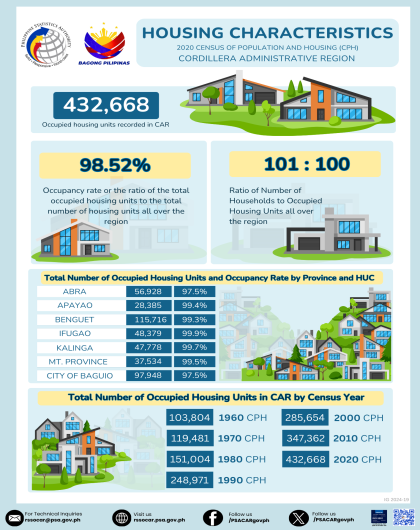Every country needs information on its residents for purposes of planning, development, and improvement of quality of life. Effective planning necessitates the use of reliable, up to date, accurate, complete, detailed and disaggregated information about the population and housing units. Such information enable both the public and private sectors to plan for better services, improve quality of life and solve pressing problems.
The Census of Population and Housing (CPH) is a national government undertaking that involves collection, compilation, evaluation, analysis and dissemination of data on population count, demographic and socio-economic characteristics of the population, housing characteristics, household characteristics and barangay characteristics in each barangay, city/municipality, province and region throughout the country. It is aimed to provide government planners, policy makers, and administrators with population and housing data on which to base their social and economic development plans, policies and programs.
Specifically, the CPH aims to gather data on:
- demographic characteristics, such as the size, composition (sex, age, and marital status), and geographic distribution of the population;
- socio-economic characteristics of the population, such as birth registration, religious affiliation, citizenship, ethnicity, functional difficulty, residence of the mother at the time of birth of the household member, residence five years ago, literacy, highest grade/year completed, school attendance, place of school, overseas worker, usual activity/occupation, kind of business/industry, class of worker, place of work and selected fertility indicators;
- household-level characteristics, such as land ownership, presence of operator in crop farming, livestock and poultry raising, aquaculture fishing, and other farm/activity, language/dialect generally spoken at home, residence five years from now, presence of household conveniences/information and communication technology (ICT) devices/vehicles, and internet access and use;
- housing characteristics, such as the number of housing units in the country, their geographic location, structural characteristics, and selected families; and
- barangay characteristics, such as the presence of selected facilities and number of establishment by type and employment size, which will be used as bases for urbanrural classification of barangays; presence and number of informal settlers (households) and relocation areas; and occurrence and number of households who moved in/out of the barangay due to various reasons such as natural and man-made disasters/calamities, relocation, peace and order problems, and others (demolition or commercialization) and specific barangay/s of origin/destination.
Meanwhile, the Community Based Monitoring System (CBMS) refers to an organized technology-based system of collecting, processing, and validating necessary disaggregated data that may be used for planning, program implementation and impact monitoring at the local level while empowering communities to participate in the process. It entails a census of all households in the community, wherein individual- and household-level information are obtained by face-to-face interview of a responsible member of each household in the community. Through the conduct of the CBMS, several local-level key development indicators that capture various aspects of quality of life in cities and municipalities will be gathered and compiled, particularly on: (a) health, (b) nutrition, (c) housing, (d) water and sanitation, (e) basic education, (f) income, (g) employment, and (h) peace and order.
The 2021 Pilot CBMS aims to list buildings, housing units, and households through 2021 CBMS Form 1 (Listing Record of Buildings, Housing Units, and Households). Data on the demographic and socio-economic characteristics of the households as well as selected household-level and housing characteristics, on the other hand, will be collected through CBMS Form 2 (Household Profile Questionnaire). CBMS Form 3 (Waiver/ Consent Form) will also be administered to solicit the consent of the household respondent for LGU and PSA to be able to share their personal and household data to other NGAs with social development programs that may/might help them. Moreover, CBMS Form 4 (Barangay Profile Questionnaire) will collect data on general information about the barangay LGU, physical characteristics of the barangay, service institutions, and infrastructure. In view of the need to record geolocation and general information about service facilities, government projects, and natural resources, the CBMS Form 5 (Service Facilities, Government Projects, and Natural Resources Geotagging Form) will also be used to collect location data and other information about the government projects and natural resources in the barangay. Consequently, a CBMS Form 6 (Listing Record of Service Facilities, Government Projects, and Natural Resources) will be generated to a list of service facilities, government projects, and natural resources in the locality.
The main objectives of the CBMS are as follows:
- To generate updated and disaggregated data necessary for targeting beneficiaries;
- To conduct more comprehensive poverty analysis and needs prioritization; and
- To provide information that will enable a system of public spending that warrants government allocation on areas and populace that are most wanting.
All the personal information collected will remain strictly confidential and will not be used for the purpose of investigations in relation to any criminal, administrative or tax liabilities of a data subject, pursuant to the CBMS Act and the Data Privacy Act of 2012.


